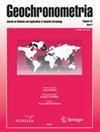使用OSL、137Cs、210Pbex、树木年代学和微形态学解释波兰黄土地区的土壤侵蚀——案例研究:Biedrzykowice遗址(波兰)
IF 0.9
4区 地球科学
Q3 Earth and Planetary Sciences
引用次数: 14
摘要
摘要黄土高原农业区易受土壤侵蚀。波兰黄土地区的土壤侵蚀从新石器时代开始,一直断断续续地持续到今天。本文介绍了137Cs和210Pbex方法同时应用于黄土坡面农田的土壤侵蚀结果。此外,为了确定与水坡侵蚀有关的堆积沉积物的年龄,应用OSL测年、选定的物理化学和微观形态分析。研究地点(Biedrzykowice、Proszowice高原、Małopolska高地)的137Cs和210Pbex沉降物的参考值分别为2627(45%与切尔诺贝利有关)和4835 Bq·m–2。农田测量的137Cs和210Pbex库存结果分别为730至7911和1615至11136 Bq·m–2。平均土壤侵蚀量约为2.1 kg·m–2·a–1(约1.4 mm·a–2)。崩坡积物的堆积始于新石器时代,在中世纪急剧增加。由于侵蚀加剧,Biedrzykowice的已检查冲沟集水区可能发展得相当快。这导致该地区被废弃为农田,因此,由于该地区的木本植被进入,斜坡上的水侵蚀降至最低。同位素测量和树木年代学表明,在过去70年中,由于第二次世界大战后的森林砍伐和中断后该地区的密集农业再利用,侵蚀过程高度加剧。本文章由计算机程序翻译,如有差异,请以英文原文为准。
Interpretation of soil erosion in a Polish loess area using OSL, 137Cs, 210Pbex, dendrochronology and micromorphology – case study: Biedrzykowice site (s Poland)
Abstract Loess areas used for agriculture are susceptible to soil erosion. The intensive process of soil erosion in Polish loess areas began with the onset of the Neolithic and has continued intermittently until today. This work presents the results of soil erosion from simultaneous use of the 137Cs and 210Pbex methods on an agricultural field located on loess slope. Moreover, to establish the age of accumulated sediment connected with water slope erosion, OSL dating, selected physicochemical and micromorphological analyses were applied. The reference values of the 137Cs and 210Pbex fallout for the studied site (Biedrzykowice, the Proszowice Plateau, Małopolska Upland) equal 2627 (45% connected with Chernobyl) and 4835 Bq·m–2, respectively. The results of the 137Cs and 210Pbex inventories measured for the agricultural field range from 730 to 7911 and from 1615 to 11136 Bq·m–2, respectively. The mean soil erosion is about 2.1 kg·m–2·a–1 (about 1.4 mm·a–1). The accumulation of the colluvial sediments started in the Neolithic and drastically increased in the Middle Ages. The examined gully catchment in Biedrzykowice has probably developed quite rapidly as a result of increased erosion. This resulted in the abandonment of this area as farmland and, consequently, in the minimization of water erosion on the slope due to the entrance of woody vegetation in this area. Erosion processes were highly intensified during the last 70 years as a result of deforestation after World War II and intensive agricultural reuse of this area after a break, as indicated by isotope measurements and dendrochronology.
求助全文
通过发布文献求助,成功后即可免费获取论文全文。
去求助
来源期刊

Geochronometria
地学-地球科学综合
CiteScore
2.20
自引率
0.00%
发文量
1
审稿时长
>12 weeks
期刊介绍:
Geochronometria is aimed at integrating scientists developing different methods of absolute chronology and using them in different fields of earth and other natural sciences and archaeology. The methods in use are e.g. radiocarbon, stable isotopes, isotopes of natural decay series, optically stimulated luminescence, thermoluminescence, EPR/ESR, dendrochronology, varve chronology. The journal publishes papers that are devoted to developing the dating methods as well as studies concentrating on their applications in geology, palaeoclimatology, palaeobiology, palaeohydrology, geocgraphy and archaeology etc.
 求助内容:
求助内容: 应助结果提醒方式:
应助结果提醒方式:


